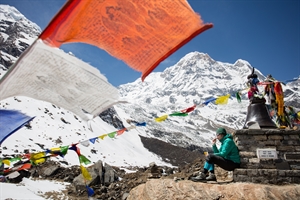If you are off on an adventure to Everest Basecamp or climbing Kilimanjaro, you’ll be spending time above 2,400m, which means you need to be aware of acute mountain sickness (AMS). Other destinations at altitude are Bogota in Columbia, Quito in Ecuador, Lhasa Tibet and La Paz, Bolivia.
What is altitude sickness?
It is more difficult for your body to absorb oxygen from the air at high altitude because the pressure is lower than it is at sea level. Your body can adapt to this situation, but it needs a bit of time to get used to it – this is known as acclimatization. You can help your body acclimatize by:
- ascending slowly – about 300m a day with a rest day every three to four days
- eating a high-calorie diet
- keeping your fluids up
Some people find the drug acetazolamide (Diamox) helps with acclimatization.
If you fail to acclimatize, you will be susceptible to acute mountain sickness. Flying straight into a place above 2,400m puts you at risk of AMS.
Symptoms of acute mountain sickness occur within the first 36 hours of arrival, and may feel a bit like a hangover:
- breathlessness
- dizziness
- fatigue
- headache
- interrupted sleep
- nausea or vomiting and loss of appetite
Read more about altitude sickness on My Health Alberta.
Is altitude sickness dangerous?
If you continue to climb higher, acute mountain sickness may become very serious indeed. It can progress to one of two lethal conditions, high altitude cerebral oedema (HACE), which affects the brain, and high altitude pulmonary oedema (HAPE), which affects the lungs. At altitude, symptoms such as confusion and unsteadiness and breathlessness at rest should be considered medical emergencies. A person with suspected HACE or HAPE may not be thinking clearly, and needs to be carried to a lower altitude immediately.
I think I have altitude sickness
Do not ignore the symptoms of AMS. Mild altitude sickness will pass if you descend or acclimatize at the same altitude. Do not go higher. Let your travel companions know you how you are feeling. Rest, take painkillers for the headache and keep your fluids up. If your symptoms do not improve after a day, descend by 500-1,000m. Get medical help if you do not improve after this.
Other things to think about before travelling to a high altitude
Will it affect your medical condition?
Anyone with a medical condition like diabetes or asthma should see their normal healthcare provider before they visit a region at altitude. You may also wish to talk it over during your travel health appointment with the specialist nurses at our travel clinics in Okotoks, Red Deer, Calgary, Edmonton, Fort McMurray and Medicine Hat.
Are you insured?
Your normal provincial health insurance may not cover you if you need to be evacuated from a remote area abroad. Purchase adequate travel insurance before you leave Canada.
UV radiation at altitude
You will be more exposed to UV radiation when you are at altitude, which puts you at risk from sunburn. A top quality sunscreen with an SPF of at least 15 that protects against UVA, UVB and UVC is strongly recommended. Apply it regularly. Apply sunblock to your lips, ears and nose, and protect eyes with wrap-around sunshades.

